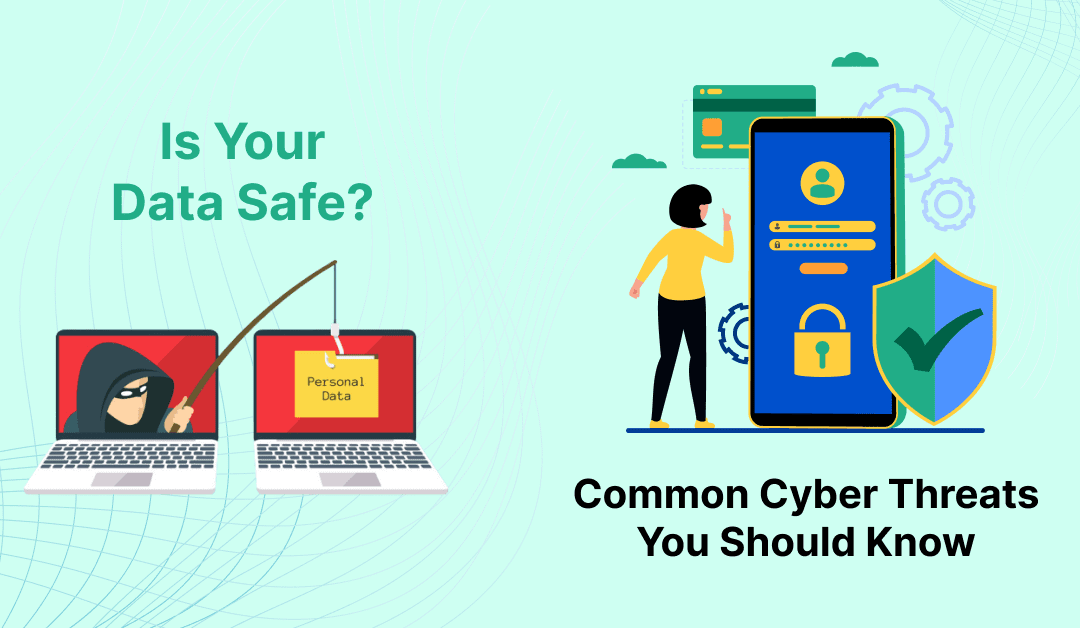Is Your Data Safe? Common Cyber Threats You Should Know
Shield Your Digital World: A Simple Guide to Cyber Security
In this interconnected world, our digital lives are as essential as our physical ones. From banking to shopping, socializing to working, we depend on technology for almost every aspect of our lives. However, this digital convenience comes with a growing risk: cyberattacks. These digital threats can steal your money, damage your reputation, and even compromise your safety. Understanding these threats and taking proactive steps is crucial to protecting yourself and your loved ones.
Let’s dive into some of the most common Cyber Threats you should be aware of:
1. Phishing: The Art of Deception
Phishing is a social engineering tactic where cybercriminals attempt to trick you into revealing personal information. They often pose as legitimate entities like banks, social media platforms, or government agencies. Common phishing methods include:
- Email Phishing: Deceiving you into clicking on malicious links or downloading attachments.
- Smishing: Similar to phishing but via SMS.
- Vishing: Using voice calls to extract information.
- Whaling: Targeting high-profile individuals or executives.
How to protect yourself:
- Be wary of unsolicited emails or messages.
- Verify the sender’s identity before clicking any links or downloading attachments.
- Use strong, unique passwords for all your accounts.
- Enable two-factor authentication (2FA) whenever possible.
2. Malware: The Digital Menace
Malware is malicious software designed to harm your computer or steal your data. It comes in various forms, including:
- Viruses: Self-replicating code that spreads to other files.
- Worms: Self-propagating malware that can spread without user interaction.
- Trojans: Disguised as legitimate software but contains malicious code.
- Ransomware: Encrypts your files and demands a ransom for decryption.
- Spyware: Collects information about your online activities.
How to protect yourself:
- Keep your operating system and software up-to-date.
- Use reputable antivirus and anti-malware software.
- Be cautious about downloading files from unknown sources.
- Create regular backups of your important data.
3. Denial-of-Service (DoS) Attacks: Overwhelming the System
A DoS attack aims to make a network or system unavailable to users by overwhelming it with traffic. Distributed Denial-of-Service (DDoS) attacks involve multiple computers attacking a target simultaneously.
How to protect yourself:
- If you’re a website owner, implement DDoS protection measures.
- For individuals, there’s limited protection, but staying updated on software can help mitigate risks.
4. Data Breaches: The Exposure of Sensitive Information
A data breach occurs when sensitive information is accessed and stolen without authorization. This can lead to identity theft, financial loss, and reputational damage.
How to protect yourself:
- Use strong, unique passwords for all your accounts.
- Enable two-factor authentication.
- Be cautious about sharing personal information online.
- Monitor your financial accounts regularly for suspicious activity.
5. Social Engineering: Manipulating People
Social engineering is the art of manipulating people into revealing confidential information or performing actions that compromise security. This can happen through phishing, but also through other tactics like pretexting (pretending to be someone else).
How to protect yourself:
- Be skeptical of unsolicited requests for personal information.
- Verify the identity of anyone requesting sensitive data.
- Educate yourself about common social engineering tactics.
Protecting Yourself: Building a Digital Fortress
While it’s impossible to eliminate all risks, you can significantly reduce your vulnerability by following these essential steps:
- Strong Passwords: Create complex passwords using a mix of uppercase and lowercase letters, numbers, and symbols. Avoid using easily guessable information.
- Two-Factor Authentication (2FA): Enable 2FA whenever possible to add an extra layer of security.
- Beware of Phishing: Be cautious of suspicious emails, texts, or calls. Avoid clicking on links or downloading attachments from unknown sources.
- Keep Software Updated: Regularly update your operating system and software to patch security vulnerabilities.
- Use Antivirus Software: Protect your devices with reputable antivirus software.
- Back-Up Your Data: Regularly back up your important files to an external hard drive or cloud storage.
- Secure Your Wi-Fi: Use a strong password for your home Wi-Fi network and consider using encryption.
- Online Privacy: Be mindful of the information you share online and adjust privacy settings on social media.
- Secure Your Smart Home: Protect your IoT devices with strong passwords and keep them updated.
- Educate Yourself: Stay informed about the latest cyber threats and security best practices.
Protecting Your Business: Safeguarding Digital Assets
Businesses are prime targets for cyberattacks. Implementing robust cybersecurity measures is essential to protect sensitive data, maintain customer trust, and prevent financial losses. Key steps include:
- Employee Training: Educate employees about cyber threats and how to identify phishing attempts.
- Network Security: Implement firewalls and intrusion detection systems to protect your network.
- Data Encryption: Encrypt sensitive data to prevent unauthorized access.
- Incident Response Plan: Develop a plan for responding to cyberattacks.
- Regular Security Audits: Conduct regular assessments to identify vulnerabilities.
The Human Factor: Your Strongest Defense
Cybersecurity is not just about technology; it’s also about human behavior. Staying vigilant and informed is crucial. Be cautious of suspicious activities, avoid sharing personal information online, and educate yourself about the latest threats. Remember, cybersecurity is an ongoing process, and it requires constant attention and adaptation.
By understanding the cyber threat view and implementing these protective measures, you can significantly enhance your digital security and protect yourself from becoming a victim of cybercrime.
The Bottom Line
Cybersecurity is an ongoing challenge that requires constant vigilance. By understanding the threat aspect, implementing robust security measures, and fostering a culture of digital awareness, individuals and businesses can significantly reduce their risk of falling victim to cyberattacks. Remember, prevention is key. Stay informed, be cautious, and protect your digital world.

